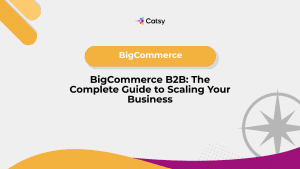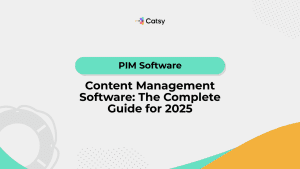7 Steps to Creating Tailored Content to Grow Sales

In this Article
More than 2,500,000,000,000,000,000 bytes of data are made or Posted Online Every Day.
Yes, and every moment someone looks at a screen, the possibility of some content catching their eye increases. Simply dishing out more won’t automatically get you more customers. Customers are smart, so be smarter.
Break through the clutter if you want to be a customer-centric brand.
This post will explain seven easy-to-understand steps for tailoring your content to improve sales, grow market share, and increase revenue.
But first, you need to know…
Why Tailored Content?
Did You Know that 90% of All Online Data Worldwide was created in the Past Two Years? (source)
With all that data, your content is unlikely to appeal to customers if it doesn’t speak directly to their needs. Everyone seeks product information and content to benefit them and their needs.
Tailored content is All About Personalization.
Make your business one that’s concerned with satisfying the particular needs of your customers to hyper-charge the customer experience you provide. Tailored content is about delivering experiences that speak directly to each customer.
It’s the Perfect Way to Deliver Solutions that Customers aren’t Yet Aware of
Personalized content is the heart of the new age digital revolution, helping digitally-savvy shoppers discover what they want, when they want it, and how they want it, with minimal effort.
Personalized Product Content Helps Customers Find Their Way by Placing Them at the Center of the Digital Shopping Experience
Tailored content facilitates the buyer’s journey because the process will make more sense to your customers. Tailoring messages to customer behavior, demographics, and searches makes conversions more likely.
Tailored Content Increases Engagement by Speaking Directly About the Personality of the E-Commerce Retailer
This deepens the relationship your customers have with your brand. First-time shoppers will want to stick around if content speaks directly to them, and content relevant to their problem or need does this.
Start with Research and Ask Yourself…
Who Are My Customers?
Tailor Content Won’t Suit Your Customers’ Needs if You Don’t Know At Least as Much About Them as They Know About Themselves.
Buyer personas are generalized descriptions of people who make up your ideal market. But the trick is to make them as detailed as you can.
How is it Possible to Make Buyer Personas Both General and Detailed?
By including as much information about them as possible:
- Age
- Behavior
- Gender
- Job
- Income
- Education
- Status
- Likes
- Wants
- Needs
- Motivations
- Difficulties
- Fears
- Values
You Might Think it’s Most Important to Know What Your Customers Want to buy, but don’t Forget About Why.
For example, are they buying for themselves, to give to others as a gift, or for further resale? You need to know whether your business is specific to different demographics or does more business on holidays.
Knowing Your Customers Inside and Out Speaks to Your Brand’s Authenticity.
You need to know their reasons for buying from you and what doubts they have about you. You also need to find out which media they use regularly so you can make sure you’re reaching them.
Find all this information by:
- Surveying your customers directly
- Studying their past purchases
- Examining their account setups
- Looking at your site analytics
- Going through their profiles
- Soliciting feedback
- Reviewing and responding to comments
Two eCommerce retailers may be functionally identical, but appearing the same will spell eCommerce suicide.
What’s even more important is to revisit buyer personas occasionally. The audience you had when you started your business is unlikely to be the same group of people you’re selling to today.
Who are You Selling to Now?
Your target audience is, at best, simply older than they were when you started. Do they like the same things and find information in the same ways? Alternatively, they might be a completely different group of people, with preferences you never considered.
And ask…
Who is My Competition?
You Should Routinely Visit Your Competitors’ Websites and Social Media Pages.
This is a good way to stay on top of current trends and gauge your competitiveness. Knowing what your competitors are doing allows you to spot gaps in your service and content to fill.
It’s a Great Way to Come Up with New Blog Ideas.
Some companies, like Buzzsumo and Ahrefs, provide products like consolidated lists of content by URL and the number of social media shares. However, doing the research yourself comes with two distinct advantages.
- It’s free.
- You are likely to find more than just what you are looking for.
Researching yourself is not easy, but the price is right. Who knows what you will find? Because research companies provide a specific product, they may not be set up to get you that little something extra you can see by accident yourself.
Differentiate Yourself.
Developing your brand involves communicating something to your customers that your competitors are not. Your tailored content must strategically highlight how your offer is different and superior to other companies in your space.
Tie Functionality to Benefit to Sell Your Brand.
Directly trashing your competition with a long, complicated list of everything you offer that they don’t will turn potential customers off. Instead, provide easy-to-absorb examinations of how your products’ features translate into concrete benefits for anyone who buys from you. Back these up with customer testimonials and reviews.
2. Dynamic Landing Pages
How Customers Find Your Site is Equally Important as Them Finding It in the First Place.
You already know who your customers are and where they exist online. Your landing pages need to reflect this origin. Each link you share should lead to a landing page personalized to the interests and needs of the specific persona you target in that space.
If a Potential Customer Clicks One of Your Links and Doesn’t Immediately Find What They Want, Guess What They’re Going to Do?
With personalized landing pages, you can simultaneously reduce your bounce rate and demonstrate your commitment to your customers. Dynamic landing pages can be set to display a wide variety of information based on how each visitor arrives.
Set Landing Pages to Change by Keyword Searched, Too.
You don’t always have to build content from scratch to cater to different market segments. Making a few minor tweaks to your targeted content is easy and far more likely to pay off than presenting everyone with the same message. Also, if you want to increase lead generation, it’s essential to tailor calls-to-action by persona.
When are Your Offers Being Made?
There are several time-related factors to keep in mind if you want your content to resonate more deeply with your potential customers:
- Are you channeling your social media posts to reach your target audience?
- Have you set up automatic emails that trigger when a purchase is made or by length of time since then?
- Do you collect personal information about your customers, like birthdays or work anniversaries, which also trigger emails?
- Are your systems designed to leverage Christmas or another holiday when your sales tend to spike?
- Do your products have a long history, or have they changed significantly in ways you can highlight in your content?
- Can you create or participate in events that would allow you to highlight your company and products?
You Need to Offer…
3. Personalized Website Design
Reduce the likelihood that your customers will abandon shopping carts.
Your website design and layout can be more instrumental in keeping customers glued to your website than you think. This is especially true when websites are designed with customer preferences in mind. You should offer a persona-centric website experience to make customers comfortable and fulfill their expectations.
Personalization of Your Homepage Will Increase Online Sales.
You must craft your website’s design with your buyer personas in mind. The more your website gives customers what they expect to experience, the more time they will spend there. As a prospect spends more time on your site, your chances of making a sale increase dramatically.
Your Website Needs to be Packed with…
4. Personalized Product Descriptions
Descriptions are the Virtual Equivalent of a Sales Pitch.
Product descriptions answer customer questions and give customers the information to make informed purchase decisions. You can tailor product descriptions to your customers using your buyer personas.
Under-Promise and Over-Deliver.
Many sites miss the mark from the beginning by writing specifications instead of accurate descriptions. Specifications do not communicate experience because they focus on what a product is, not how it will solve their customers’ problems.
Customize Descriptions by Including Only What Customers Care About.
Just because you think something is important doesn’t necessarily mean your customers will, too. Help customers by replacing bland, repetitive language with specific, helpful information. Also, make suggestions that make sense with what they want to buy.
Less is More.
This is especially true for those well-versed in scanning pages. You can attach more detailed descriptions to address further concerns. Also, use easy-to-understand grammar and vocabulary.
Revisit Your Content Regularly.
It’s going to take Google about 35 weeks to rank your pages. Once you’ve identified old or stale content, update it quickly. Remember, just because your blog post popped when you wrote it, doesn’t mean it will be forever, so update anything that looks dated.
Your Descriptions Need to Feature…
5. Rich Product Images
One drawback of e-commerce is its lack of Urgency.
Your customers won’t be able to pick up and hold the products you’re offering, so your pictures have to do the work. All product details must be precise, so the same hand-held feeling comes through.
Include Resolution Pictures Taken from All Angles.
This will help clear up any misgivings customers have about buying from you. Ensure you have a relevant picture for every product variant and show the product used with associated products.
Here, it’s Better to Provide More Than Not Enough.
People often abandon purchases because they can’t reconcile product images against descriptions. They need to see highly detailed images, so they don’t feel the need to examine the item in person. Including a variety of close-up photos of your products will dispel customer doubts.
Pay Close Attention to…
6. Customer Ratings and Reviews
Publish All the Reviews You Receive, Whether Positive or Negative.
When you get negative ones, reply courteously and strive to bridge the service gap. Oftentimes, if you turn bad reviews around, you can turn customers into brand advocates.
Negative Reviews are Golden Opportunities to Turn a Prospect Around.
Have a personalized system for handling complaints and negative reviews. Address each one personally to show prospects you hear them, even if you don’t immediately have a solution.
You can Also Find Out About Potential Customer Questions on Q&A Sites.
Use sites like Quora and Yahoo Answers to identify potential customers’ questions before they find your website. Make sure that if you use these sites for marketing purposes, you state your intentions clearly and at the beginning of your post.
Nothing Erases Brand Authenticity Faster Than Deception.
These websites are another way to learn about and stay ahead of trends. The Internet isn’t doing anything if it’s not changing constantly, and research is the only way to keep up.
Monitor Social Media to Demonstrate Customer Satisfaction.
You could manually publish positive customer comments and tweets or set up a stream to bring them in as you “like” them. Use these to add that pop to your landing pages, too.
Don’t Forget to…
7. Tailor Content by Specific Channel
The Average Facebook User is 40 and a Half Years Old. (Source)
But is that the same for Twitter, Pinterest, and LinkedIn? Not. Each channel you sell on already attracts a specific type of visitor, so you can only disregard those differences to your detriment. New channels are coming up, and older channels are going out of style, so figure out how to stay on top of those changes.
The average age of customers who buy on Amazon is 37.
It’s not an overstatement to say you’re unlikely to enjoy the benefits of personalization unless applied across all digital channels your customers interact with. Documents, text, images, manuals, and other business tools inform your customers about products and services. All these must include tailored content.
Finally…
How is Personalized Content Powerful in Selling?
Customized content is essential for winning on the digital shelf. With so much information available to consumers, standing out with personalized value-driven content is the most effective way to convert buyers into loyal customers.
What is Tailored Content?
Tailored content is personalized messaging designed to meet the specific needs and interests of your target audience. Unlike mass-market content, it adapts based on customer behavior, preferences, and even location.
For example, a clothing brand could show winter jackets to customers in colder regions and summer apparel to those in warmer areas. The key to successful tailored content is delivering the right message to the right person at the right time.
The Case of Tailoring
Tailoring your content ensures that your brand understands and values the unique needs of your customers. This approach can:
Build trust
Increase on-site engagement
Drive higher conversion rates
By aligning your content with customer needs, you create a more relevant and effective experience, ultimately benefiting both your audience and your business.
Bring It All Together
Nobody’s Going to Read Your Content if it’s Not Informative.
According to McKinsey and Company, the three consistency Cs of customer satisfaction are practiced; the easiest way to say this is to make promises you can keep and then keep them. (source)
Customer Experience is as Much a Promise as High Product Quality, Good Prices, and Fast Delivery.
Personalized content is your path to improving overall customer experience and overcoming the constant stream of new competitors. This, of course, relates positively to sales because personalized content warrants continuous consumption, keeping customers coming back to your site.
Now that you know why product content needs to be tailored to boost sales, click here to see what Catsy can do for you.
Product information management (PIM) is a catalog software tool built to speed products to market.
Digital asset management (DAM) is a software used to organize and enrich digital assets.




